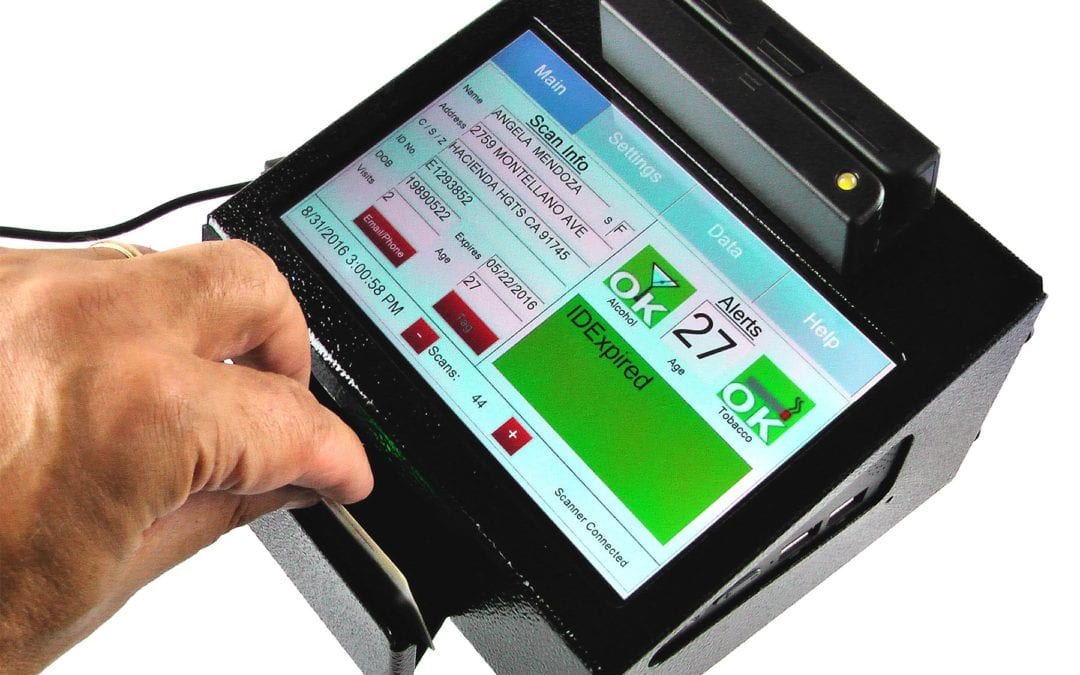Checking IDs with an ID Scanner Tutorial
Believe it or not, over 65% of the tickets issued for serving a minor is due to mathematical errors, mental shortcuts, or rushing through the checkout process. The sting operations run in most states know that the pressure of fast service plus the repetitive nature of checking ids leads many to take short cuts. These sting operations use undercover agents whose ID is a few days short of legal age and take advantage of this aspect of human nature. The main purpose of an ID scanner is to automatically read the age and expiration date off of the drivers license and calculate if a person is under age or if the ID is expired. The secondary purpose of the ID scanner is to document the age verification process, which is necessary to prove due diligence if claiming affirmative defense. An ID scanner will also help catch some fake IDs if the barcode information does not match the printed information on the front of the license, however an ID scanner should not be considered to be a fake ID catcher. Fake IDs are like fake $20 bills, they range in quality and any company which claims to “stop” fake IDs is stretching the truth.
This article assumes that you’ve already purchased a good ID scanner. If not, visit our home page where you can find our products.
Accurately Checking IDs uses a combination of technology like ID scanners, plus some common items like Ultra Violet lights and 10x Magnifiers, and a bit of detective work.
When checking IDs, it is important that the ID scanner is set to the correct date and time. Most ID scanners have real-time clocks, but if initially incorrect then the age and expiration calculations will be incorrect. Therefore, it is important to make sure the clock is set correctly.
When a person presents you an ID card, ask the person to hand you the ID. If the ID is in a wallet or has a protective overlay asked that it be removed.
First, scan the ID in the ID scanner. A good ID scanner will warn you visually and with audible alarm if the person is under age or the ID is expired. A good ID scanner will take approximately one to two seconds to scan and report back with the results.
Next, look at the display of the ID scanner and compare it to the printed information on the front of the ID to check for discrepancies. A high-quality ID scanner will display certain information like the person’s name, ID number, date of birth, expiration date, gender, etc. Does the name match? Is the gender correct? Some fake IDs will have somebody else’s barcode on the back so the age will be correct but the names will not match.
While holding the ID in your hand look at the person standing in front of you. Do they look like the person in the photo on the ID? If the ID has height, hair color, or eye color printed on the front of the ID, compare it to the person standing in front of you. Do they match up?
When comparing the information printed on the front of the ID, feel the surface of the ID, run the ID between your fingers, look for uneven areas, cuts in the surface, lifted lamination, or how the ID flexes. One test used in New York is to fold the drivers license. In New York when unfolded the ID will not have a crease whereas many fakes will leave fold line or actually crack. Look at the quality of the printed text on the front of the ID card as well. Check the printed words on the ID card and look for letters which are not straight or jagged printing which may indicate a fake or altered ID.
It is not essential, but having a good flashlight can be useful. Hold the ID card in the light and look for cuts, pinholes, punch outs, and areas which are overly light or overly dark. Any of these may also be an indication the ID has been tampered with.
If available hold the ID under a UV light source. Most drivers licenses’ these days have invisible ink that will become visible only under UV light. You should be aware of what the UV light pattern looks like in your state and of other states if you see many out-of-state IDs. You may also consider purchasing an ID checking guidebook.
Also if available and if time permits, look at the ID under 10x or 20x magnifying glass. Most IDs have what’s called micro-printing. This is a print that looks like a straight line to the human eye, but under magnification is actually a series of small characters. Become familiar with the micro-printing in the your state, as well as others if you see many out-of-state licenses. If you are unfamiliar with micro-printing then again consider purchasing an ID checking guide which lists micro-printing features of the various states.
If you are still unsure then quiz the person presenting the ID card. Here are some questions you can ask them:
- What is the postal code and street address on the drivers license?
- How old are you? (some kids don’t know that what the fake ID says)
- What is their zodiac sign?
You can also request them to sign their name and compare it to the signature on the ID card. You can also ask for other forms of IDs which have their names on them. People sometimes loan the drivers license, but rarely credit cards to others.
Finally, if you are still not 100% sure just refuse to sell them alcohol and tobacco.
Here are additional posts on checking IDs

